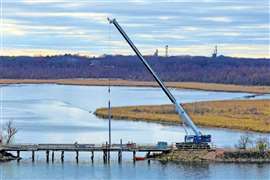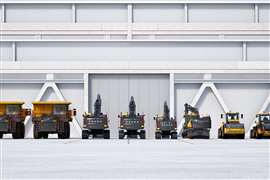Avoiding a clash
15 April 2008
The number of cranes over a city is widely regarded as a good indicator of economic The number of cranes over a city is widelyactivity. A scan of the London skyline shows construction to be in full swing (see IC January, London towers). Construction for the 2012 Olympics is yet to kick in, established tower crane companies are continuing to expand their fleets and new entrants are making a considerable impact, so the level of confidence is clearly very high. It is not only the sheer number of cranes on the skyline — unlike cities elsewhere, the London skies are dominated increasingly by luffing jibs, particularly on City and Docklands area projects to the East of the capital.
Whatever the pros and cons of luffing versus saddle jib cranes and the reasons for the dominance of luffers on London sites, one particular safety aspect has been dramatically highlighted by recent events. With sites packing more luffing jibs onto a site than ever before, collision avoidance has become both more important and more complex.
Current regulations and guidance, for example, the recently revised BS7121, spell out the need to manage the collision risk and offer a number of potential solutions. Driver training and experience, good communications, effective planning and control of lifts are all essential requirements on any site but, as recent events have shown all too clearly, they are not enough.
While the primary responsibility for collision avoidance must always remain with each crane driver, human errors can and do occur and an electronic anti-collision system provides a fully automatic back-up to support the drivers.
Crane collisions are relatively commonplace yet, thankfully, mostly without injury to personnel. Ask a crane driver if he has hit and he may well choose not to admit it, but, ask him if his ropes have been hit by another driver and the answer is very different. Collisions often go unreported and the term ‘soft in to describe one crane touching the hoist ropes of another. This term, however, can be dangerously misleading as even the smallest nudge, displacing a load by an inch or two, can be enough to crush a banksman's hand, or worse.
More or less risk?
The recent collapse of a luffing jib in central London raises the question whether there are factors specific to luffing jib cranes that increase the potential for collisions. Is the risk less or greater than with saddle jib cranes? Many site managers believe that luffing jibs pose less of a collision risk than saddle jibs. They suggest that there is less risk as one jib does not normally oversail another. But is this really true, or is the risk of collisions between luffing jibs perhaps higher than for saddle jibs?
First, luffing jibs allow more cranes to be placed on a site without the difficulties and costs of oversailing rights (having to obtain permission and pay for crane jibs that slew above neighbouring properties). Project planners like to see plenty of hooks, sometimes to the detriment of operating efficiency. Four or five hooks all able to access any spot on the ground is now commonplace, and more hooks inevitably means more collision possibilities.
Second, the planning of luffing jib lifts requires an additional parameter to be taken into account. Preventing collisions between saddle jib cranes is primarily a two-dimensional problem, but the luffing jib crane has a variable overall height, which creates additional collision risks that are extremely difficult to judge from either the ground or the cab.
Third, unlike saddle jib cranes erected at staggered heights where the risk is normally that of the jib or counterjib of a lower crane colliding with the hoist ropes of a higher crane, luffing jibs are routinely able to collide jib to jib. Not only is this an additional hazard, but the forces at play in a jib to jib clash can be catastrophic. The luffing jib is indeed a very powerful machine, and the prospect of, for example, one jib being driven up under the counterjib of another crane is almost certain to lead to a major structural failure of one or both machines.
Finally, consider the additional responsibilities and difficulties faced by the driver of the luffing jib crane. He has a whole new problem ahead of him or, rather, he does not. While a saddle jib is literally in front of him, the head of his luffing jib may be typically 40 to 50 metres above him. The potential collision can take place literally as high above him as he is from the ground. While focused primarily and necessarily on his hook, perhaps 50 metres below, he is required to assess and manage a range of different and potentially life threatening risks over a vertical range of typically 100 metres and needing a field of vision of around 160 degrees.
Help to control
So how can we help drivers and their managers control these additional risks? One solution is an electronic collision prevention system working in the background, supporting the driver and safeguarding against human error. Anti-collision systems need not interfere with normal crane operations; most drivers will be unaware of the system because it only comes into play when a driver has been unsighted or distracted and has been unable to make the judgement for himself.
Such systems are not new; they were first introduced in 1985 in response to an unacceptable number of collision incidents and have been in constant development through several generations of technology to the present day. Current systems use software created specifically to manage the geometry of luffing jibs, and can be used to manage all variations of potential collision, involving virtually any combination of jibs, counterjibs and ropes.
Under European legislation, all tower cranes must be capable of accepting the installation of an anti-collision system and several major crane manufacturers have embraced this philosophy by incorporating specific interfaces for the leading anti-collision systems. This cooperation ensures that anti-collision systems take full advantage of the cranes' increasingly sophisticated electronic control schemes.
So, is an anti-collision system a useful addition in the safe operation of luffing jib cranes? It cannot and must not replace driver responsibility, but the answer lies clearly in the actions of many of our largest construction companies which specify anti-collision systems as a matter of course. Are they mistaken? Again, ask a driver if he needs an anti-collision system and his sense of pride may sometimes lead him to say “no.” But ask him if the drivers of the adjacent cranes on his site need one and it will be a resounding “yes.”
The good news is that with many sites now specifying collision prevention systems, an accident between luffing jib cranes, as seen recently, will become a thing of the past.





